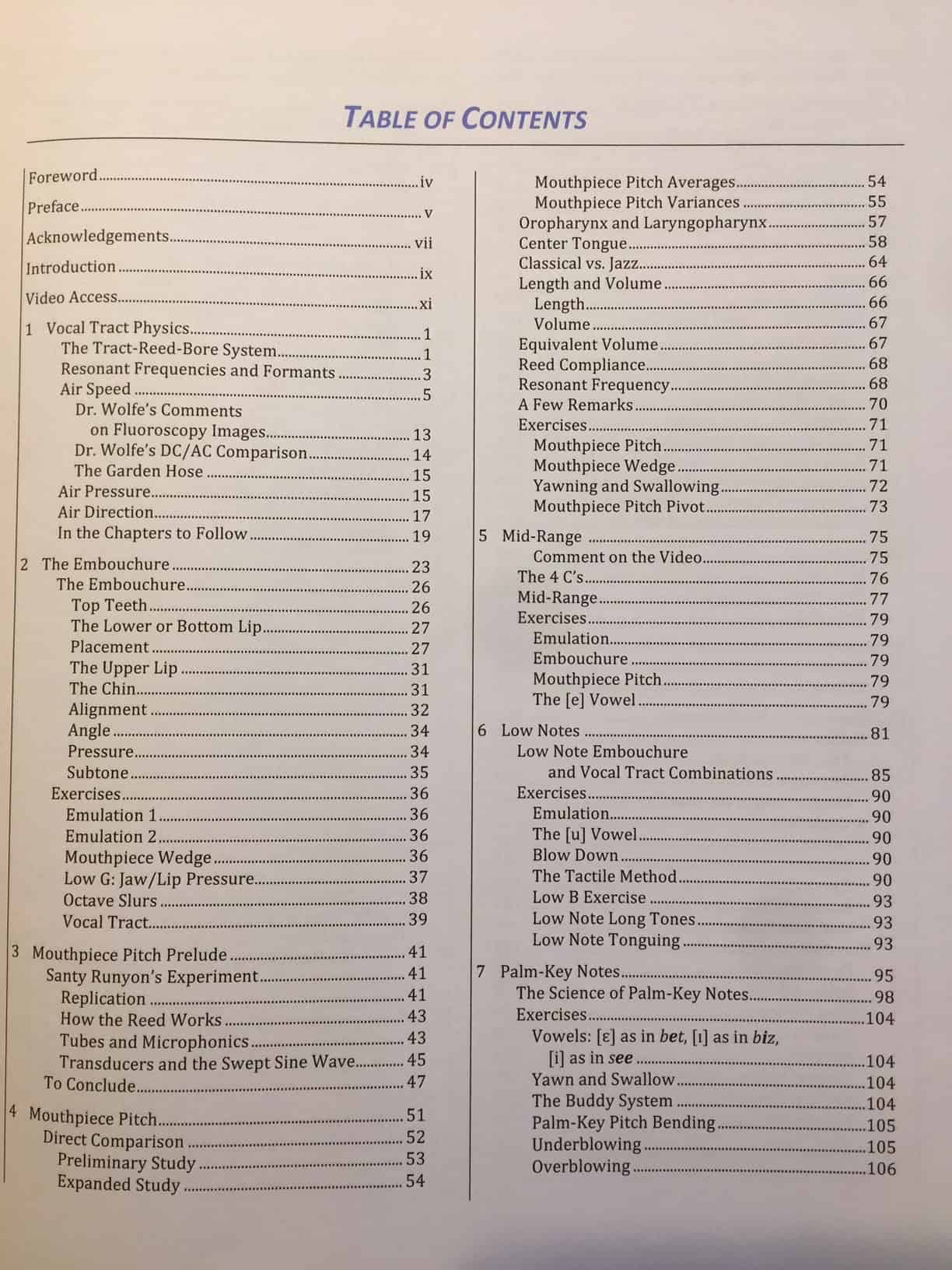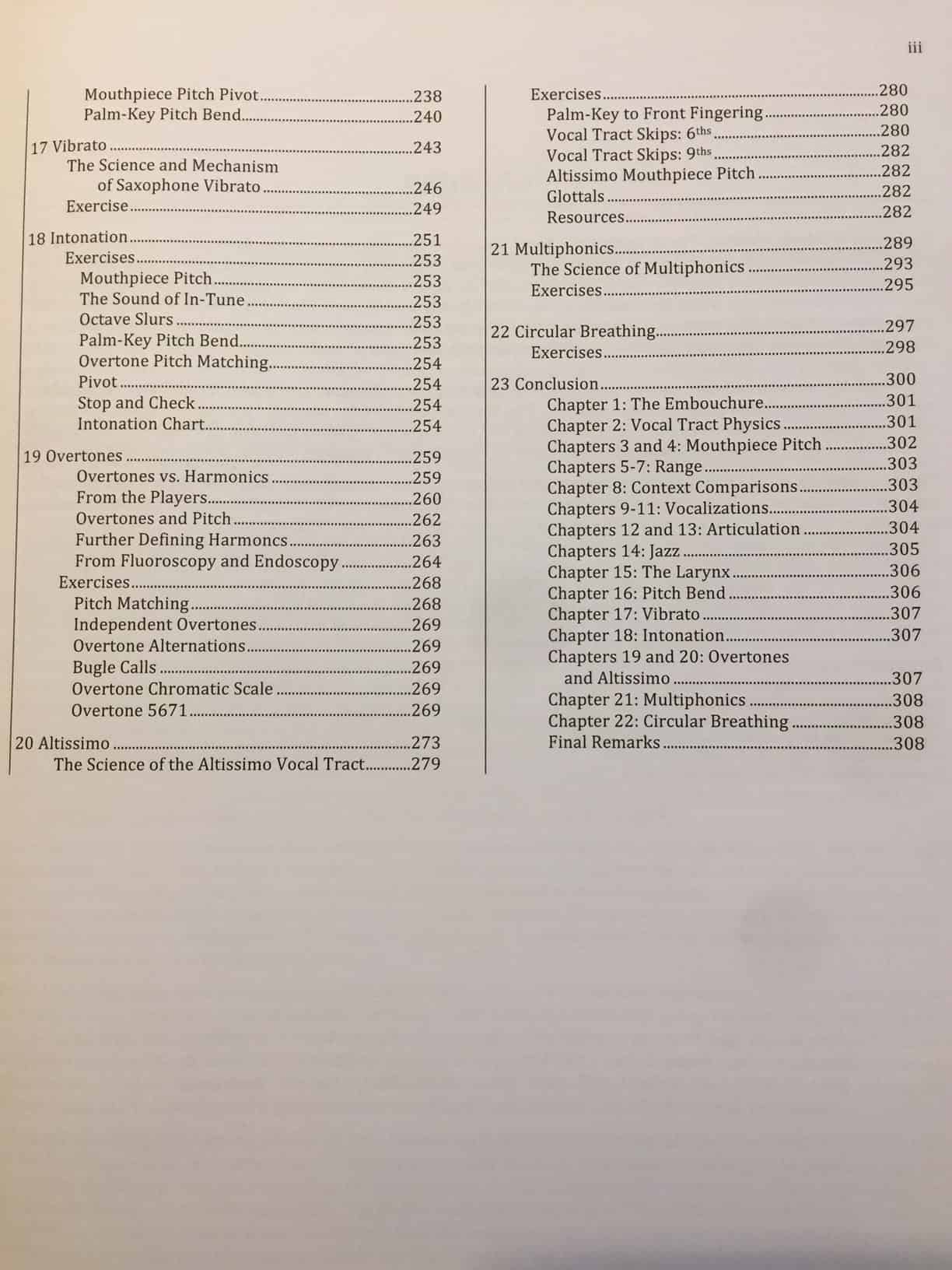Today, I am reviewing “From the Inside Out” by Dr. Mark Watkins that is published by Outskirts Press. “From the Inside Out” is a revolutionary in-depth 309 page resource book for the development of saxophone sound. When this book is described as “in-depth”, Dr. Watkins is not joking! It is 309 pages of descriptions, scientific data, scientific and medical terms, a plethora of fluoroscopy and endoscopy photos (photos and scans of the inside of the mouth and vocal tract) as well as countless diagrams, charts, illustrations and a variety of quotes from saxophone players, teachers, doctors and scientists. (In fact, 92 subjects participated in a variety of vocal tract and saxophone tone production projects)

From the Inside Out: An In-depth Resource for the Development of Saxophone Sound
Here is a description of this amazing resource from Amazon:
From the Inside Out: An In-depth Resource for the Development of Saxophone Sound
With a doctorate in five woodwind instruments and decades as both a performer and a teacher, Dr. Mark Watkins has long been interested in the production of sound. What differentiates his book “From the Inside Out: An In-depth Resource for the Development of Saxophone Sound” from other music reference texts is its focus on fluoroscopy and endoscopy to supersede supposition and speculation. No other book provides both video and hard-copy illustrations of the inner workings of the saxophonist’s vocal tract. Since 1995, Watkins has conducted X-ray and probe camera experiments and consulted with music acoustics physicists from around the world. Now, Dr. Watkins shares what he has learned in From the Inside Out, which is filled with explanations and exercises for saxophone performers and teachers in areas including range, relations to vocal mechanisms, articulation, jazz, anatomy, the science of the vocal tract, and extended techniques.

From the Inside Out: An In-depth Resource for the Development of Saxophone Sound
Instead of writing a list of all of the subjects that “From the Inside Out” covers, I have decided to include some photos of the extensive table of contents for you to browse through.
From the Inside Out-Table of Contents-Page 1
From the Inside Out-Table of Contents-Page 2
From the Inside Out-Table of Contents-Page 3
As you can see from perusing the topics above, this is a book full of research and material on a variety of subjects related to the saxophone! This list is exciting to me as these are the very subjects that are so confusing to many students. Overtones, tonguing, intonation, voicing, altissimo, embouchure, etc……..
I started reading through the book with the intention of making notes and underlining insightful thoughts and findings in red pen and quickly found most of my book full of red lines, stars and notes! Even though I have been playing the saxophone now for 40+ years, I found the information inside this book fascinating and enlightening!
Not only does the book come with all the resources listed above but it also come with a multitude of online video resources to learn from. The first video (Chapter 2: 01 EMBOUCHURE Inside Out) is a video from inside the mouth of someone playing the saxophone. Although some will find this gross, I found this video fascinating as you can see what is actually happening with the tongue, reed, lips and teeth. Wow! Here is a link Dr. Mark Watkin’s Youtube Page where he has uploaded all the videos that go with “From the Inside Out”.
The book starts with Chapter 1 on “Vocal Tract Physics” which I found fascinating. To be honest, “From the Inside Out” is probably as far as you can get on the other side of the descriptive spectrum from “Just put the saxophone in your mouth and blow…….” (when I first started teaching saxophone I probably said that some 25-30 years ago!)
“From the Inside Out” delves into all the details of many of the processes happening while we play the saxophone. If you could care less about all these details, this book is probably not for you. If, on the other hand, you would love to read all about the fine details in regard to playing the saxophone then this is the perfect book for you!
If you have ever wondered about the answers to questions such as these then you should read “From the Inside Out”:
- What position should my tongue position be in when I play the saxophone?
- How fast or hard should I blow my air?
- Do high notes require faster air speed than low notes?
- What does it mean to “open my throat”? Should I do it? How do I do it?
- How much pressure should be on the reed from the lower lip? Should it increase for the higher notes and altissimo range?
- What is the Venturi effect? How does it apply to playing the saxophone?
- What is going on physiologically when someone plays in the altissimo range?
- Why do sax players have different embouchures and what difference do different embouchures make?
- How much mouthpiece should I take in my mouth?
- What mouthpiece pitch should the mouthpiece have by itself while blowing?
- What is going on inside the vocal tract of players that can bend these mouthpiece pitches?
- What is the best way to articulate on the saxophone?
These are just a few of the questions answered in “From the Inside Out”. If you have ever wondered about any of these questions then this is a book worth getting. For the first time that I have seen, Dr. Mark Watkins has compiled a resource with actually photos and scans of what is actually happening inside of us when we are playing the saxophone.
In the past, teachers all basically taught what we perceived or felt was happening inside us. Many times, we felt at a loss for words on how to describe what was happening inside of us while we were playing. Now, in “From the Inside Out” there is ample proof and data to either solidify our existing perceptions or to convince us to tear down those old perceptions and start building more factually accurate descriptions and explanations.
I will also warn you that if you read the above questions and assume that you have all the right answers to these questions, this book might surprise you. The answers you have been giving to student all these years might not be entirely correct or they might even be 100% incorrect!
I would encourage anyone that teaches the saxophone to get this book. Obviously, if you are reading this review, then you probably have a passion for playing the saxophone and this book might interest you. Those of us that teach however, have the added weight and responsibility on us to teach correctly and factually also. This book is especially for those of us who have pursued a profession of teaching the saxophone and want all the facts and truths available so that we can become even better teachers!
The first chapter alone reads like a college text book and is full of fluoroscopy photos of the inside of the vocal tract, diagrams listing all the physical components of the human body involved in using the vocal tract, definitions of some common and less common words involved, mathematical formulas, and many charts and graphs.
Interlaced within all of these elements are straight forward explanations and discussions that might disrupt some of your “saxophone teacher” truths. In fact, many times the book references what many saxophone teachers teach and then explains how some of these beliefs are incorrect or misinformed. I personally encountered many topics that were addressed that I teach a certain way that this book shines an illuminating light on.
I have to admit that the common quotes of what “most” saxophone teachers teach and then the discussions and straight forward explanations afterwards are what interest me the most about this book. My mind can get a bit lost with the discussions of mathematical formulas and words such as resonant frequencies and acoustic impedance but give me a practical real world description and application and I am all over that! Dr. Watkins does a great job of mixing these down to earth nuggets of real world saxophone applications in with all the heavier scientific data points so that an average saxophone player should be just as intrigued by this information as the advanced doctorate student might be.
Thanks to Dr. Mark Watkins for writing such an in-depth and complete study on saxophone playing as well as sending me a book to review. I look forward to continuing to work through it and already appreciate all the insight and knowledge it is giving me as a saxophone player and teacher.
If you end up getting From the Inside Out: An In-depth Resource for the Development of Saxophone Sound please feel free to come back and share your thoughts and comments with all of us below.






Steve,
Thank you for this book review.
If one wanted to read some sample chapters from the book on the vocal tract, one could go here and read/download them:
http://emp.byui.edu/WatkinsM/applied/printableresources.htm
There is other material here as well such as sax exercises.
Thanks Walter! I sent a message to the author to see if I can post the URL to the videos also. Not sure if he wants everyone to have access to these or if they are just for people that own the book. Didn’t want to post the URL without his permission. Steve
That book seems amazing, congrats. I will check it out for sure!
Thanks for reviewing this fascinating book Steve, lots of new information, wow!
Steve,
Thanks again for bringing this book to our attention.
It is too bad there isn’t a quick and cheap way of getting the helpful info in this book to us, like a summary, quick start or companion guide.
If you decided to put together one of your videos on what you learned from this book and the important take-aways, I for one would buy this video.
Just a thought. If you decided to take on the project, I know you would do an excellent job.
Hi Walter, That’s a great idea! I’m sure bits and pieces will come out in my video lessons as I teach along the way but maybe in the future I can focus on what I learned from the book on certain topics more specifically. It is a great resource for teachers that is for sure! Steve
Steve,
You have been a real leader in jazz education and have done excellent reviews of numerous books .
Perhaps your teaching video series could include a section specifically addressed to book reviews – what the author is saying and what are the take home messages/how we apply the new info, etc ?
This way we know where to find the take away info you discovered.
Thank you.